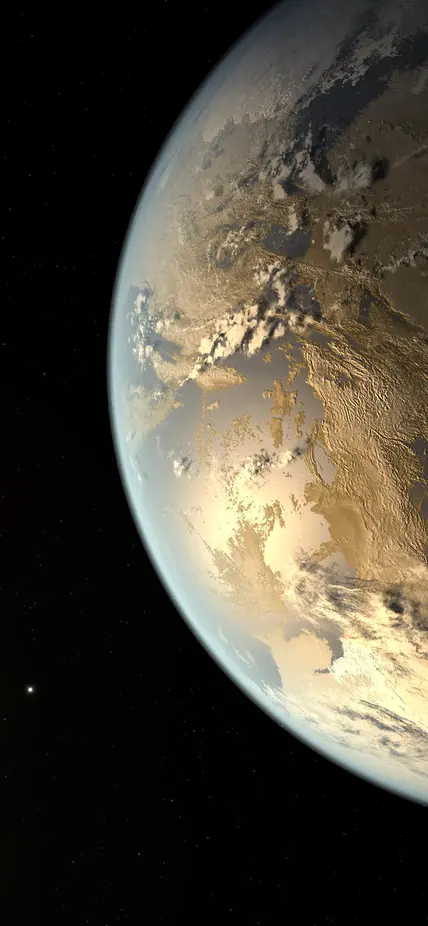Today, a NASA study to be published in The Astronomical Journal announced that between 37% and 88% of sun-like stars might have rocky worlds orbiting in their Habitable Zones (HZ). The team of scientists, which includes Carnegie Science Earth and Planets Laboratory (EPL) astrophysicist Alan Boss, looked at Kepler data from over 80,000 stars and determined that there is roughly one Earth-like planet for every two sun-like stars in our galactic neighborhood, a higher frequency than previously imagined.
We asked paper co-author Alan Boss to comment on this exciting finding.
![]()
First, tell us a little bit about who you are. What do you study, and what do you do at the Carnegie Science Earth & Planets Laboratory?
I calculate theoretical models of stellar and planetary system formation, lead the Carnegie Astrometric Planet Search program at Las Campanas, chair the technology assessment committees for NASA's Exoplanet Exploration Program and the Coronagraph on the Roman Space Telescope, and write popular books on the history of exoplanet discoveries.
As a co-author of the recent paper “The Occurrence of Rocky Habitable Zone Planets Around Solar-Like Stars from Kepler Data,” can you briefly describe this study’s goal?
The goal was to perform the final, definitive analysis of the transit photometry data generated by NASA's Kepler Space Telescope in order to determine the frequency of habitable rocky planets orbiting sun-like stars.
What was your role in this research?
I was a member of the Kepler Science Team from 2001 to 2012, when the prime mission ended. I was also a member of the Kepler Science Council from 2008 to 2009. I was on the Scientific Organizing Committee for the First Kepler Science Conference in 2011 and co-chair of the Scientific Organizing Committee for the Second Kepler Science Conference in 2013.
To start us off, what is the "Habitable Zone"?
The Habitable Zone is basically the distance from the star where a rocky world would be expected to have liquid water on its surface, based on its surface temperature.
What is Kepler, and how do scientists actually use Kepler data to find these planets?
Kepler was a 95-cm space telescope that measured the brightness of over 150,000 stars for four years, looking for the small dips caused when an exoplanet passed periodically in front of stars.
The time between these dips defines the exoplanet’s orbital period and—by Kepler's Laws—the orbit’s size. Hence, we can determine the distance to the star, which in turn determines the surface temperature.
The dip’s magnitude determines the planet’s size with respect to the star, and hence if it is likely to be Earth-like in radius.
EPL's Paul Butler and Johanna Teske discover exoplanets by a different method, where spectrometers measure the Doppler shift of lines in the host star's spectrum, in order to measure the orbital period and mass of the planet as it orbits around the center of mass of the star-planet system.
You can find more details in the three books I have published about the history of exoplanets.
Why does this study look for habitable zone planets around G and K dwarf stars specifically?
Such planets are the closest analogies to our Earth and hence top the list of possible abodes for life outside the Solar System.
So, based on this recent paper, how many habitable zone planets do you suspect are out there?
The final analysis reveals that between 37% and 88% of sun-like stars have rocky worlds orbiting in their star's habitable zone (HZ).
Within ten parsecs of the Sun, about 19% of the stars are sun-like, i.e., G and K dwarfs. Most, about 69%, are M dwarfs with masses less than 1/2 that of the Sun.
What are the broader implications? Why do astronomers look for Habitable Zone planets?
We are looking for life beyond the Solar System to answer the question, "Are we alone?".
Were there any surprises or challenges?
The main problem was that Kepler only detected a handful of such planets, meaning that the team had to exercise extreme care in correcting any observational biases in analyzing the data.
How does this information change the previous understanding of exoplanet occurrence rates? Are there more or less than we thought?
Before Kepler, all we had were guesses as to the frequency of Earth-like planets. There were no good reasons to expect such a high frequency as what we found with Kepler.
Now that we know these occurrence rates, what’s next for future research?
NASA plans to build a large space telescope that will search for Earth-like worlds in orbit around the closest stars, and to determine if any of these worlds show evidence for being inhabitable, or possibly even inhabited.
Do you think we will ever actually get to go to one of these planets?
Privately funded initiatives are already underway to attempt this audacious task. It is only a matter of time (pun intended).
In your opinion, what is the most exciting takeaway from this study?
We expect that most of our closest stars will have Earth-like worlds to study—they are quite common in the universe. This makes NASA's job much easier than it would be if such worlds were rare.
Alan Boss is the Chair of NASA’s Exoplanet Exploration Program Technology Assessment Committee, was a member of the Kepler Science Team from 2001 to 2012, and has written several popular books about the exciting field of exoplanet research including Universal Life: An Inside Look Behind The Race to Discover Life Beyond Earth (2019), The Crowded Universe: The Search for Living Planets (2009), and Looking for Earths: The Race to Find New Solar Systems (1998).
